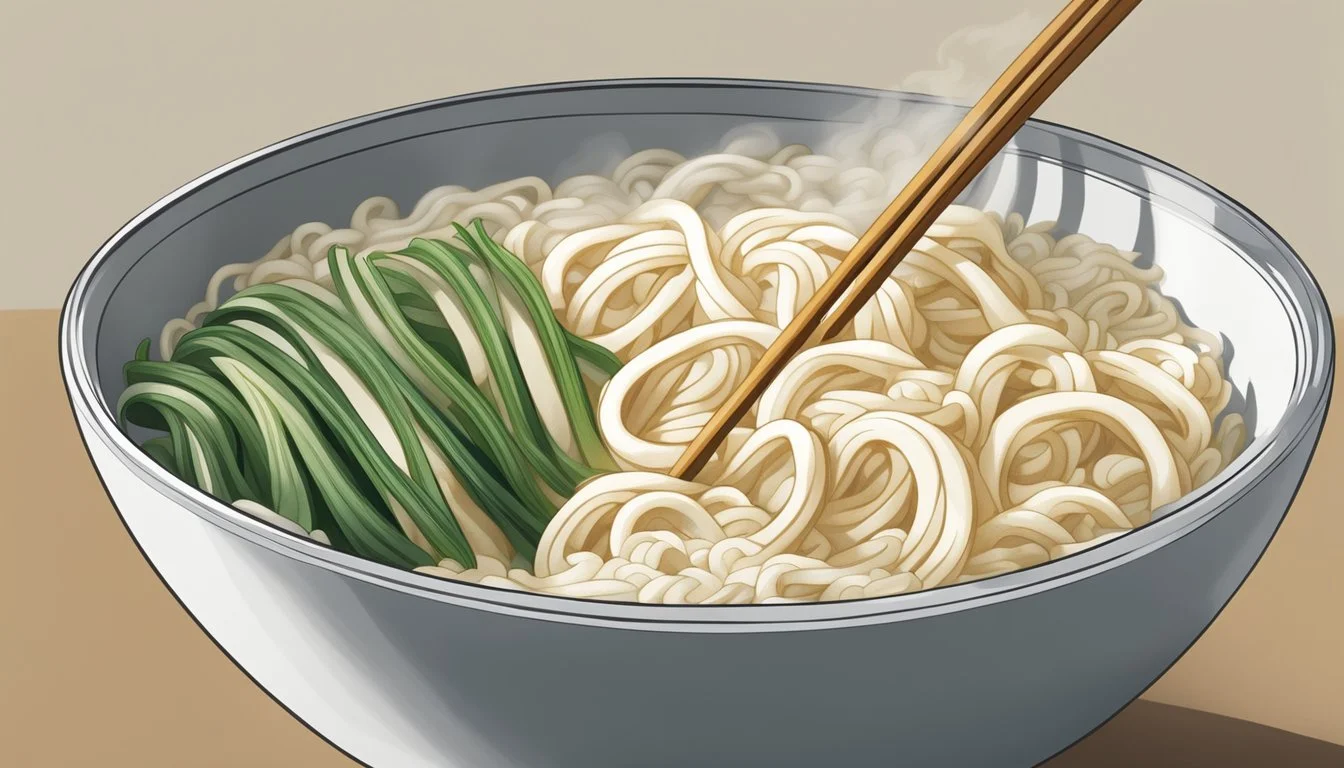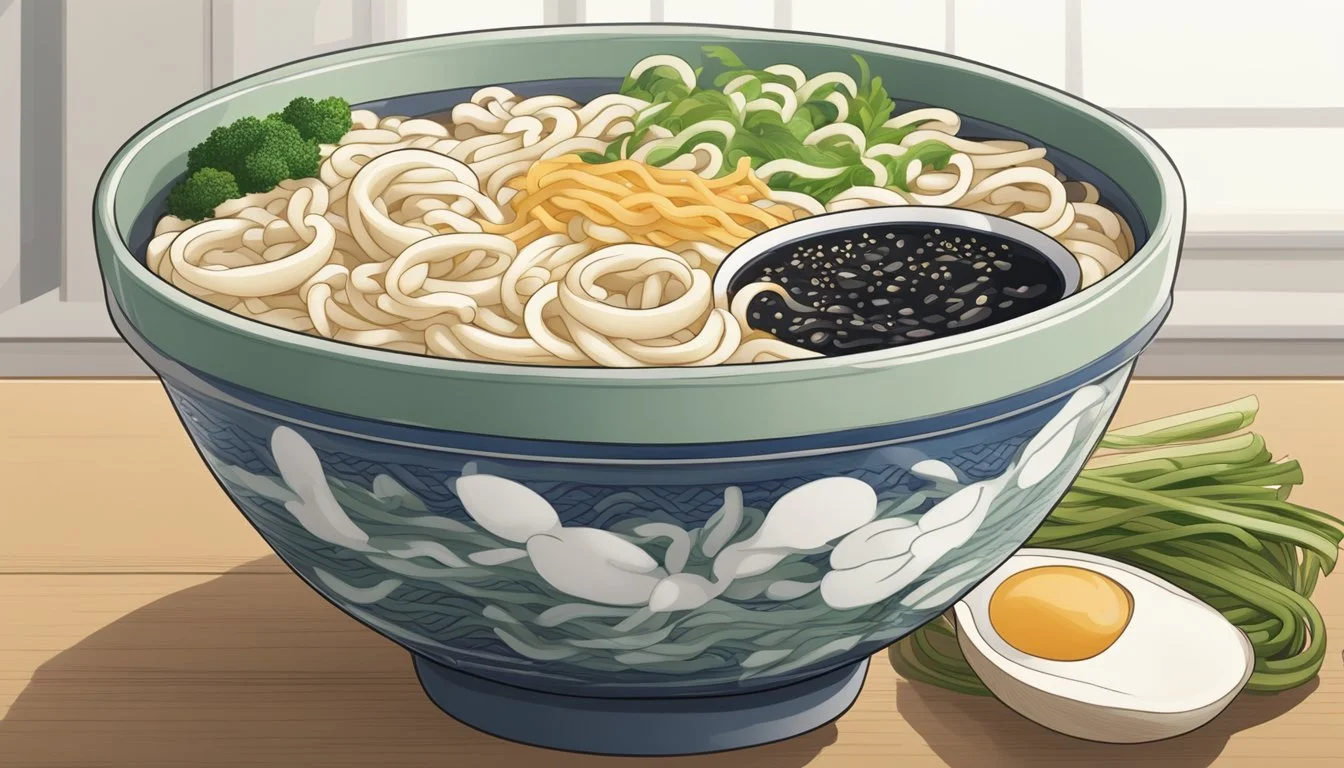Fresh vs Frozen Udon: A Comparison of Texture, Taste, and Convenience
Udon noodles, a beloved staple of Japanese cuisine, captivate food enthusiasts with their thick, chewy texture and versatile nature. These wheat-based noodles come in various forms, with fresh and frozen options being popular choices for home cooks and restaurant chefs alike.
Fresh udon noodles offer superior texture and taste, while frozen udon provides convenience without significantly compromising quality. Fresh udon, often vacuum-sealed and refrigerated, boasts an authentic chewiness that many consider unmatched. Frozen udon, on the other hand, maintains much of its original texture and flavor when properly prepared, making it a practical alternative for quick meals.
Both fresh and frozen udon can be used in a wide array of dishes, from hot soups to cold salads and stir-fries. The choice between fresh and frozen often depends on availability, storage capabilities, and personal preference. Regardless of the form, udon noodles remain a delicious and satisfying option for those seeking to explore Japanese culinary traditions.
Understanding Udon
Udon noodles are a staple of Japanese cuisine, known for their thick, chewy texture and versatility in dishes. These wheat-based noodles have a rich history and come in various forms, including fresh and frozen varieties.
The History and Origin of Udon
Udon noodles originated in Japan, with their exact beginnings shrouded in legend. Some stories trace their introduction to Buddhist monks who brought noodle-making techniques from China in the 8th century.
Over time, udon became deeply ingrained in Japanese culinary culture. Each region developed its own unique udon styles and preparations.
Udon gained popularity due to its simple ingredients and filling nature. Made primarily from wheat flour, salt, and water, these noodles provided sustenance for people across all social classes.
Characteristics of Udon Noodles
Udon noodles are distinguished by their thickness and chewy texture. They are typically 2-4 mm in diameter and have a smooth, white appearance.
The noodles are made from wheat flour, which gives them their signature elasticity and bite. Salt and water complete the basic ingredient list.
Udon's neutral flavor allows it to absorb the tastes of broths and sauces effectively. This versatility makes udon suitable for both hot and cold dishes.
The texture of udon can vary slightly depending on the production method and region. Some styles are softer, while others maintain a firmer consistency.
Fresh Udon vs. Frozen Udon Overview
Fresh udon noodles are often considered superior in texture and flavor. They have a soft, chewy consistency and require minimal cooking time.
Frozen udon offers convenience without significantly compromising quality. These pre-cooked noodles can be quickly reheated and added to dishes.
Fresh udon typically needs about 2-3 minutes of cooking time, while frozen udon may only require 1-2 minutes to heat through.
Both varieties can be used interchangeably in most recipes, though fresh udon may absorb flavors more readily.
Frozen udon maintains its texture well during storage, making it a practical option for home cooks who want to keep udon on hand.
Nutritional Aspects
Udon noodles offer a range of nutritional benefits, with some differences between fresh and frozen varieties. These Japanese noodles provide complex carbohydrates and can be part of a balanced diet when consumed in moderation.
Health Benefits of Udon Noodles
Udon noodles are primarily made from wheat flour, water, and salt. They are a good source of complex carbohydrates, which provide sustained energy. A serving of udon noodles contains approximately 200-250 calories, making them a filling option for meals.
Udon noodles made from whole wheat flour offer higher fiber content. This can aid in digestion and promote feelings of fullness. The complex carbohydrates in udon noodles are digested more slowly, potentially helping with weight management and blood sugar control.
These noodles also provide small amounts of essential minerals like iron and manganese. While not a significant source of vitamins, udon can be part of a nutritious meal when paired with vegetables and proteins.
Comparing Fresh and Frozen Udon Nutritional Content
Fresh and frozen udon noodles have similar nutritional profiles, but there are subtle differences. Fresh udon typically contains fewer preservatives and additives. This can be beneficial for those seeking a more natural product.
Frozen udon may have slightly different texture and consistency due to the freezing process. This can affect how the noodles absorb sauces and broths, potentially impacting the overall nutritional content of a dish.
Both fresh and frozen udon are low in fat and cholesterol. They can be incorporated into various dishes, from soups to stir-fries. When choosing between fresh and frozen, consider factors like availability, storage convenience, and intended use in recipes.
Aspect Fresh Udon Frozen Udon Preservatives Fewer May contain more Texture Softer Slightly firmer Shelf life Shorter Longer Cooking time Shorter May require thawing
Culinary Uses
Udon noodles are versatile and can be used in a wide variety of dishes. Their thick, chewy texture makes them ideal for both traditional Japanese recipes and creative fusion dishes.
Traditional Japanese Dishes with Udon
Kake udon is a simple yet comforting dish featuring udon noodles in a hot dashi broth. The broth is typically seasoned with soy sauce and mirin, creating a savory base for the noodles.
Kitsune udon adds a piece of sweet and savory fried tofu to the kake udon base. The tofu absorbs the flavorful broth, complementing the chewy noodles.
Tempura udon combines crispy tempura with udon noodles in a hot broth. The contrast between the crunchy tempura and the soft noodles creates an interesting texture profile.
Curry udon features thick, hearty Japanese curry sauce poured over udon noodles. This dish offers a rich, satisfying flavor that pairs well with the chewy texture of udon.
Creative Recipes Incorporating Udon
Udon stir-fry is a popular fusion dish. The thick noodles hold up well to high heat, absorbing flavors from sauces and vegetables while maintaining their chewy texture.
Cold udon salads are refreshing in warm weather. Chilled noodles are tossed with crisp vegetables and a tangy dressing for a light meal.
Udon carbonara combines Italian and Japanese cuisines. The thick noodles work well with creamy carbonara sauce, creating a unique twist on the classic pasta dish.
Udon noodle soups with non-traditional broths, such as tom yum or pho-inspired bases, offer exciting flavor combinations. The neutral taste of udon allows it to adapt to various cuisines.
Preparing Udon
Udon noodles can be cooked using different methods depending on their form. Fresh and frozen udon require distinct preparation techniques to achieve optimal texture and flavor.
How to Cook Fresh Udon Noodles
Fresh udon noodles are thick and chewy, requiring minimal cooking time. Bring a large pot of water to a rolling boil. Add the fresh udon noodles and stir gently to prevent clumping.
Cook for 2-3 minutes until the noodles are tender but still have a slight bite. Test for doneness by tasting a noodle.
Once cooked, drain the noodles in a colander and rinse with cold water to stop the cooking process. This helps maintain their chewy texture.
For a quick meal, fresh udon can be added directly to hot soups or stir-fries without pre-cooking.
Preparing Frozen Udon Noodles
Frozen udon noodles are convenient and nearly as good as fresh ones. To prepare, fill a large pot with water and bring it to a boil.
Gently separate the frozen noodles and add them to the boiling water. Stir to prevent sticking. Cook for 1-2 minutes until they become tender and chewy.
Drain the noodles and rinse with cold water if serving in a cold dish, or add directly to hot soups or stir-fries.
For a quicker method, some frozen udon can be microwaved. Follow package instructions, typically involving adding water and heating for 2-3 minutes.
Always check the package for specific cooking times, as they may vary slightly between brands.
Texture and Taste
Fresh and frozen udon noodles offer distinct textures and flavors that can significantly impact the overall eating experience. The differences in preparation and storage methods result in unique characteristics for each type.
Fresh Udon Texture and Palate
Fresh udon noodles are prized for their exceptional texture. They have a thick, chewy consistency that provides a satisfying bite. The noodles are slippery and springy, allowing them to glide smoothly in soups or sauces.
Fresh udon's chewiness comes from its high water content and the kneading process used during production. This results in a tender yet firm texture that holds up well in various dishes.
The taste of fresh udon is subtle and slightly sweet. Its mild flavor allows it to absorb and complement the flavors of broths and sauces effectively.
Frozen Udon: Does It Hold Up?
Frozen udon noodles aim to preserve the texture and taste of fresh udon. When properly thawed and cooked, they can closely mimic the chewy texture of their fresh counterparts.
The freezing process helps maintain the noodles' structural integrity. This allows frozen udon to retain much of its springiness and slippery texture when prepared correctly.
Taste-wise, frozen udon is similar to fresh, with a mild wheat flavor. However, some consumers report a slight difference in overall flavor intensity compared to fresh udon.
Frozen udon's texture can be affected by improper storage or thawing methods. Careful handling is essential to preserve its desirable chewy consistency and prevent the noodles from becoming mushy or losing their signature springiness.
Preservation and Storage
Proper storage is crucial for maintaining the quality and safety of udon noodles. The methods differ for fresh and frozen varieties, each requiring specific techniques to maximize shelf life and preserve texture.
Storing Fresh Udon Noodles
Fresh udon noodles have a short shelf life and require prompt refrigeration. Store them in an airtight container to prevent moisture loss and contamination. Place the container in the refrigerator within 12 hours of cooking or purchasing.
Fresh udon can last 3-5 days when refrigerated properly. Keep them away from strong-smelling foods to avoid absorbing unwanted odors.
For optimal freshness, consume fresh udon noodles within 2-3 days of purchase or preparation. Check for signs of spoilage before use, such as off-odors or unusual discoloration.
Freezing and Thawing Process for Udon
Freezing extends the shelf life of udon noodles significantly. Pre-cooked udon can be frozen for up to 3 months. Use heavy-duty freezer bags or airtight containers to prevent freezer burn.
To freeze:
Cool cooked noodles completely
Portion into serving sizes
Remove excess air from packaging
Label with date and contents
To thaw frozen udon, transfer the package to the refrigerator overnight. For quicker thawing, place the sealed bag in cold water, changing the water every 30 minutes.
Reheat thawed udon by boiling for 1-2 minutes. Avoid refreezing thawed noodles to maintain food safety and quality.
Substitutes and Alternatives
Several options exist for replacing udon noodles in recipes. These alternatives cater to different dietary needs and preferences while still providing satisfying textures and flavors.
Other Noodles as Udon Substitutes
Soba noodles make an excellent substitute for udon. Made from buckwheat flour, they offer a nutty flavor and slightly chewy texture. Soba works well in soups, stir-fries, and cold noodle dishes.
Ramen noodles can also stand in for udon. While thinner, they provide a similar wheat-based flavor and soft texture. Ramen adapts well to both hot and cold preparations.
For a quick pantry option, spaghetti or linguine can work in a pinch. Though lacking the distinctive chewiness of udon, these pasta varieties can absorb flavors effectively in Asian-inspired dishes.
Gluten-Free and Vegan Udon Options
Rice noodles offer a gluten-free alternative to udon. They cook quickly and have a mild flavor that pairs well with various sauces and broths. Wide rice noodles can mimic the thickness of udon.
Shirataki noodles, made from konjac yam, provide a low-carb, gluten-free option. These translucent noodles have a unique texture and absorb flavors readily.
For a protein-rich substitute, try strips of firm tofu. When sliced thinly and lightly fried, tofu can provide a chewy texture reminiscent of udon in certain dishes.
Vegetable "noodles" made from zucchini, carrots, or daikon radish offer a fresh, low-carb alternative. These add crunch and nutritional value to dishes traditionally made with udon.
Serving and Presentation
Udon noodles offer versatile serving options, from classic soups to creative modern dishes. The presentation of udon varies between traditional and innovative approaches, each highlighting the noodles' unique texture and flavor.
Traditional Serving Methods for Udon
Hot udon noodle soups remain a popular way to enjoy these thick wheat noodles. Kake udon features a simple broth made with dashi, soy sauce, and mirin. Toppings often include sliced green onions, tempura bits, and kamaboko fish cake.
Cold udon dishes are common in summer. Zaru udon presents chilled noodles on a bamboo mat with a dipping sauce on the side. Hiyashi yamakake combines cold udon with grated mountain yam for a refreshing texture.
Udon can also be served in a variety of regional styles. Some areas prefer thicker noodles, while others favor thinner varieties. The broth and toppings may vary based on local ingredients and traditions.
Innovative Ways to Serve Udon
Modern chefs are exploring new ways to present udon. Udon salads mix chilled noodles with fresh vegetables, proteins, and zesty dressings. These dishes offer a light, refreshing take on the classic noodle.
Fusion cuisine has embraced udon's versatility. Udon stir-fries incorporate the noodles into dishes with bold flavors and diverse ingredients. Some restaurants serve udon "carbonara" or with non-traditional sauces like pesto.
Udon bowls have gained popularity in trendy eateries. These often feature a variety of toppings arranged artfully over the noodles. Ingredients might include soft-boiled eggs, roasted vegetables, and grilled meats or tofu.
Creative presentations use udon in unexpected ways. Udon "nests" cradle other ingredients, while some chefs shape the noodles into unique forms for visual appeal.
Varieties of Udon
Udon noodles come in diverse shapes, textures, and regional specialties across Japan. Each variety offers a unique culinary experience, reflecting local traditions and ingredients.
Different Types and Shapes of Udon
Udon noodles vary in thickness and shape. Round udon is the most common, with a smooth, cylindrical form. Flat udon noodles offer a broader surface area, ideal for absorbing flavors.
Dried udon noodles have a long shelf life and require longer cooking times. Fresh udon noodles, made daily, boast a superior texture and taste. Frozen udon noodles provide convenience while maintaining quality.
Thickness also differentiates udon varieties. Thin udon works well in soups, while thick noodles shine in stir-fries. Some regions produce extra-thick udon, prized for its chewy texture.
Regional Udon Variations in Japan
Japan's prefectures each have their own udon specialties. Sanuki udon from Kagawa Prefecture is renowned for its firm, chewy texture.
Musashino udon, found in Tokyo, has a distinct brown hue due to local wheat. It offers a slightly rough texture compared to standard white udon.
Tochigi Prefecture is home to mimi udon, shaped like ears. This unique variety adds visual interest to dishes.
Nabeyaki udon, popular in many regions, features soft noodles stewed with various toppings. Yaki udon, a pan-fried variant, showcases udon's versatility in both hot and cold preparations.
Purchasing Udon
Udon noodles are available in various forms at grocery stores. Shoppers can choose between fresh and frozen options, each with distinct qualities and storage requirements.
Where to Find Udon in Grocery Stores
Udon noodles are typically located in the Asian or international food section of major supermarkets. Some stores may stock them in the refrigerated or frozen foods area.
Many Asian specialty markets offer a wider selection of udon varieties. These shops often carry both fresh and frozen options, as well as dried udon noodles.
Look for udon in vacuum-sealed packages in the refrigerated section. Frozen udon is usually found in the freezer aisle near other Asian frozen foods.
Choosing Between Fresh or Frozen Udon Packages
Fresh udon noodles offer superior texture and are ideal for immediate use. They require refrigeration and have a shorter shelf life.
Frozen udon provides convenience and longer storage. These noodles maintain quality well and can be quickly prepared.
When selecting packages, check for:
Expiration dates
Package integrity
Noodle appearance (should be uniform in color and size)
Fresh udon is best for dishes where texture is crucial. Frozen udon works well in soups and stir-fries.
Consider your meal plans and storage space when deciding between fresh and frozen options. Both can deliver delicious results in various udon recipes.
Making Udon at Home
Crafting homemade udon noodles is a rewarding culinary experience that yields chewy, flavorful results. The process requires simple ingredients and techniques, allowing home cooks to create authentic Japanese noodles in their own kitchens.
Homemade Udon: A Guide to Making Noodles from Scratch
To make udon noodles, one needs all-purpose flour, salt, and water. The dough is mixed and kneaded until smooth, then rested to develop gluten. Kneading is crucial for achieving the right texture.
The dough is rolled out and folded multiple times, with rest periods in between. This process creates the characteristic chewiness of udon noodles. After rolling to the desired thickness, the dough is cut into noodles.
Fresh udon noodles cook quickly in boiling water, typically taking about 10 minutes. They should be stirred gently to prevent clumping. Once cooked, the noodles are rinsed under cold water to stop the cooking process and remove excess starch.
Homemade udon can be used immediately in soups or stir-fries, or stored in the refrigerator for later use. The fresh noodles offer a superior texture and flavor compared to store-bought versions.








